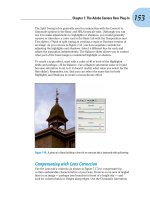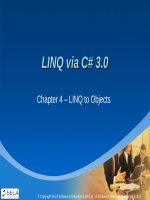Chapter 4 wrapup
Bạn đang xem bản rút gọn của tài liệu. Xem và tải ngay bản đầy đủ của tài liệu tại đây (1.88 MB, 18 trang )
Extra Credit Option:
Attend the Public Lecture by Prof. Antonio
Lazcano on Tuesday (tomorrow) evening,
Feb 11 at 7:30 PM in Gammage Auditorium
here on campus. Write up a short summary
2-3 paragraphs for the talk, highlighting
the aspects you found most interesting.
Bring your write-up to class on Wednesday.
Be sure to write your name and ASU ID at
the top of the page.
Today’s Lecture:
Plate margins and associated geological
pheneomena.
- Intraplate hot-spots.
- Divergent plate margins in continental settings
(origin of new ocean basins).
- Convergent margins
- Continental margin settings.
- Transform margins (ridge transforms and onland transforms.
Brief Review
Quiz
Next time: Interlude A and Chapter 5!
PLATE
TECTONICS
Location of Earth’s Hot-spots
PLATE
TECTONICS
Yellowstone Hot Spot
PLATE
TECTONICS
Yellowstone Hot Spot
PLATE
TECTONICS
Types of Plate Boundaries
3 types
● divergent boundaries
● convergent boundaries
● transform fault boundaries
PLATE
TECTONICS
Continental Rifting: East Africa
Red Sea (looking southeast)
PLATE
TECTONICS
Opening of the Red Sea
PLATE
TECTONICS
Opening of the Red Sea
PLATE
TECTONICS
Formation of Triple Junctions
ocean-continent
ocean-ocean
continent-continent
3 Types of Convergent Plate Margins
Types of Continental Margins
“Active”
Found along convergent
plate margins:
Primarily around the
Pacific rim.
Characterized by active
narrow continental
shelves and active
mountain building
processes (earthquakes &
volcanic activity).
Accretionary wedges of
sediment which are
scraped off the top of a
subducting slab.
Types of Continental Margins
“Passive”
Found within plate
interiors:
Continental margin not
= a plate margin
Examples are
continental margins
around Atlantic.
Broad continental
shelves consist of thick
wedges of sediment
deposited along margins
Few earthquakes or
volcanic eruptions.
Comparison of Active and Passive
Continental Margins
PLATE
TECTONICS
Transform Plate Margins
● Transform fault boundaries
Strike-slip faults where plates slide past each other:
No production/destruction
of material
Most connect mid-ocean ridge segments
Others are “on-land”
transforms like the
San Andreas Fault.
PLATE
TECTONICS
Transform Plate Margins
On-Land Transform Faults
San Francisco Peninsula
and San Andreas Fault
In-class exercise. Name:______________________
GLG 101 Prof. Far m er ASU ID:________________
Compare the continental margin of the west coast of S. America
with the east coast of N. America.
1) South Am.
2) North Am.
Questions:
a) Active or passive continental margin?
b) Draw a cross-section (a side view)
of each area, labeling the most
important features.









